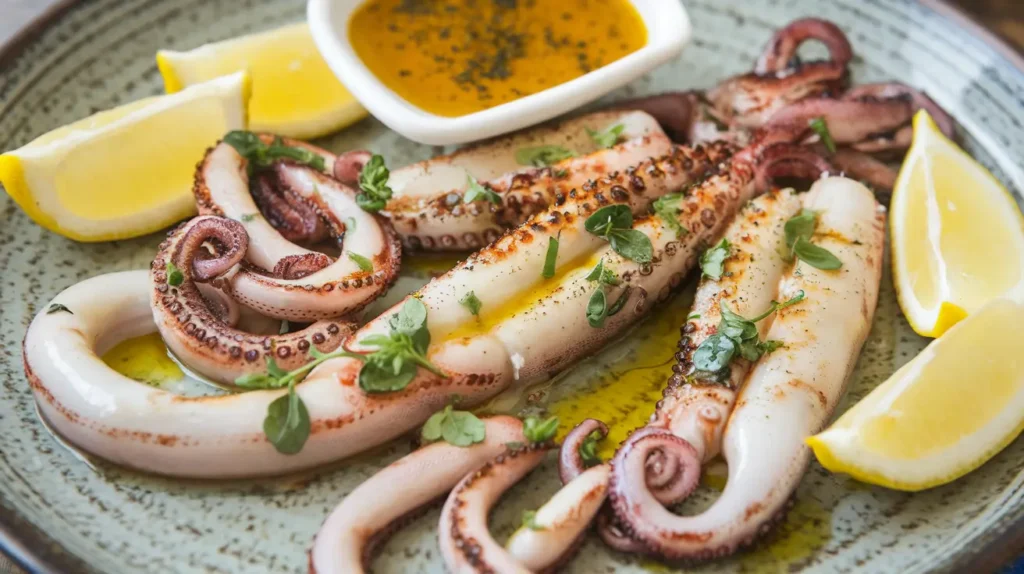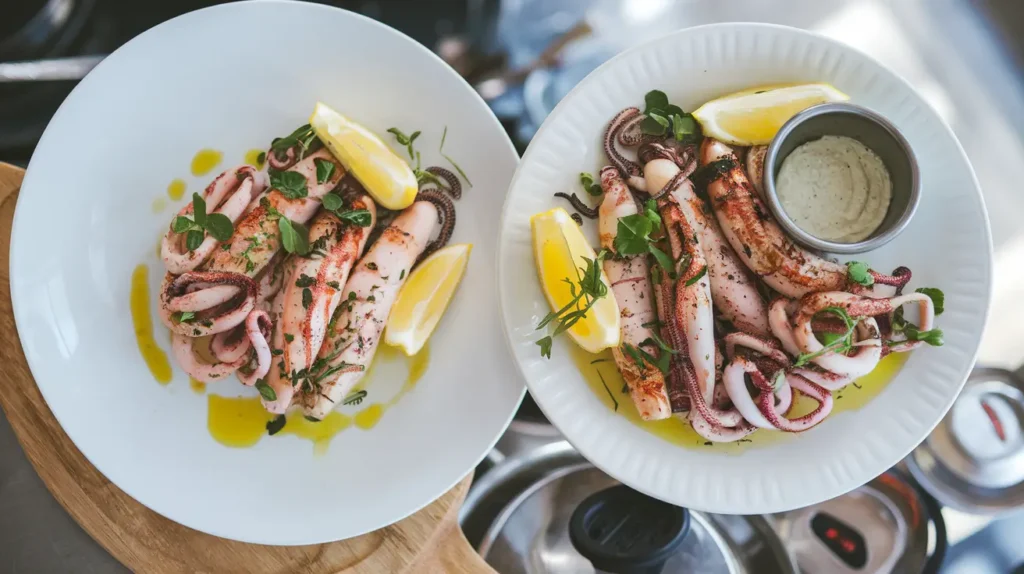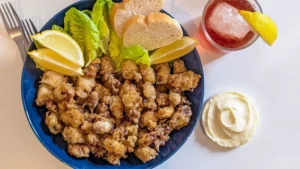🍴 “Cooking fast doesn’t mean sacrificing love.” – Spedy Recipes by Emma
Table of Contents
Growing up near a water dam, my grandma’s kitchen was always stocked with fresh catches from local fishermen. One of her secret treasures? Baby squid tiny, tender, and bursting with flavor. She’d say, “Good things come in small packages, and these little gems prove it!” Today, I’m sharing how baby squid can transform your weeknight dinners into quick, nutritious, and memory-filled moments. Perfect for busy families, these recipes blend Grandma’s wisdom with modern shortcuts. Let’s dive in!
Why Baby Squid?
Nutritional Powerhouse
Baby squid (or chipirones) are a lean protein source, rich in:
- Omega-3s for heart health.
- Vitamin B12 for energy.
- Iron and Zinc for immunity.
And at just 80 calories per 3-ounce serving, they’re a guilt-free choice!
Speed Meets Tradition
Their small size means they cook in under 10 minutes, aligning perfectly with Spedy Recipes’ mission. Plus, their mild flavor adapts to global cuisines from Mediterranean garlic sauté to Asian stir-fries.
Choosing & Prepping Baby Squid: A Stress-Free Guide
Buying Tips
- Fresh: Look for shiny, firm bodies and a clean ocean scent.
- Frozen: A convenient alternative! Thaw overnight in the fridge.
Cleaning Simplified
- Rinse under cold water.
- Remove the beak (tiny mouth) by squeezing the tentacles.
- Optional: Pull out the translucent quill (backbone).
Pro Tip: Many stores sell pre-cleaned squid ask your fishmonger to save time!
3 Speedy Baby Squid Recipes for Busy Families
1. Grandma’s Garlicky Chipirones (15-Minute Magic)
“This dish tastes like my childhood let’s create yours!”
Ingredients (Serves 4):
- 1 lb baby squid, cleaned
- 4 tbsp olive oil
- 6 garlic cloves, sliced
- 1 tsp smoked paprika
- ½ cup parsley, chopped
- Lemon wedges
- Salt & pepper
Steps:
- Heat oil in a skillet over medium. Add garlic; sauté until golden.
- Add squid; cook 2-3 minutes until opaque.
- Toss with paprika, parsley, salt, and pepper. Squeeze lemon on top!
Kid-Friendly Twist: Serve with toothpicks for “squid skewers”!

2. 20-Minute Baby Squid Stir-Fry (Modern Fusion)
“Tradition meets TikTok quick, vibrant, and oh-so-satisfying!”
Ingredients (Serves 4):
- 1 lb baby squid, sliced into rings
- 2 bell peppers, thinly sliced
- 1 tbsp ginger, minced
- 3 tbsp soy sauce (low-sodium)
- 1 tbsp honey
- 1 tbsp sesame oil
- 1 cup snap peas
- Sesame seeds
Steps:
- Whisk soy sauce, honey, and sesame oil in a bowl.
- Stir-fry ginger in oil for 1 minute. Add squid; cook 2 minutes.
- Toss in veggies and sauce; cook 3-4 minutes. Garnish with sesame seeds!
Serve with instant rice or zucchini noodles.
3. Crispy Oven-Baked Squid “Fries” (30-Minute Fun)
“Who needs takeout? Let’s make memories instead!”
Ingredients (Serves 4):
- 1 lb baby squid tubes
- 1 cup panko breadcrumbs
- 1 tsp garlic powder
- ½ cup flour
- 2 eggs, beaten
- Olive oil spray
- Dipping Sauce: Mix mayo + sriracha + lime zest
Steps:
- Preheat oven to 425°F. Line a baking sheet with parchment.
- Coat squid in flour, egg, then breadcrumbs mixed with garlic powder.
- Arrange on sheet; spray with oil. Bake 12-15 minutes until golden.
Perfect for picky eaters dip, crunch, repeat!
Grandma’s Garlicky Chipirones
Equipment
- Skillet
Ingredients
Main Ingredients
- 1 lb baby squid cleaned
- 4 tbsp olive oil
- 6 garlic cloves sliced
- 1 tsp smoked paprika
- 0.5 cup parsley chopped
- lemon wedges for serving
- salt and pepper to taste
Instructions
- Heat olive oil in a skillet over medium heat. Add sliced garlic and sauté until golden.
- Add cleaned baby squid to the skillet and cook for 2-3 minutes until opaque.
- Sprinkle smoked paprika, chopped parsley, salt, and pepper over the squid. Toss well.
- Serve immediately with lemon wedges for squeezing on top.
Notes
Cooking with Kids: Messy Hands, Happy Hearts
- Assign Tasks: Let little ones coat squid in breadcrumbs or toss stir-fry veggies.
- Storytime: Share Grandma’s fishing adventures while prepping.
- Celebrate Imperfection: Burnt a batch? Laugh it off “Our secret crispy version!”
Rich in protein and low in fat, baby squid is a healthy choice for seafood lovers. It’s also a good source of essential nutrients like vitamin B12 and selenium. For a meal that combines nutrition with taste, try a 4-Ingredient Chicken Salad alongside grilled squid.
Eating baby squid can support brain health, reduce inflammation, and even promote heart health. Who knew something so small could be so mighty?
Sustainability & Substitutions
- Eco-Friendly Choice: Opt for squid certified by seafood watch programs.
- No Squid? Swap with shrimp or firm white fish in these recipes.
For more ideas on enhancing your recipes, check out our guide on Perfect Octopus Sashimi, which includes tips on avoiding common mistakes.
Conclusion: Your Kitchen, Your Legacy

Baby squid isn’t just food it’s a bridge between generations. As my grandma always said, “The best meals are the ones shared.” So, whether you’re reviving a family tradition or starting a new one, remember: Every speedy meal is a chance to nourish both body and soul.
📸 Tag us in your #SpedyFamilyKitchen creations we can’t wait to see your twists!
Hungry for more? Subscribe for weekly recipes that turn “I’m too busy” into “Let’s cook together!” 🦑✨
- 30-Minute Ground Beef Stroganoff
- Cheesy Hamburger Rice Casserole
- Amazing Garlic Parmesan Baked Shrimp in 10 Minutes
- Garlic Butter Shrimp Pasta
- Classic Garlic Butter Shrimp Scampi (Without Wine)

